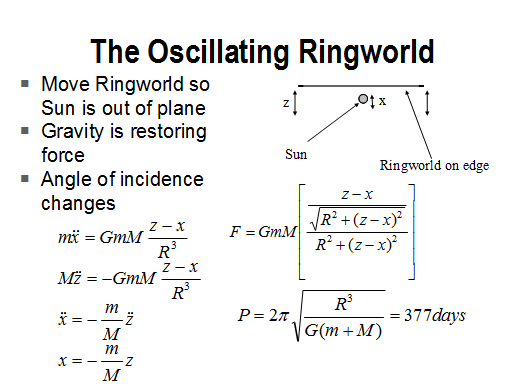
NOTES:
Here's a concept called the Oscillating Ringworld. If we move the Ringworld so that the Sun is no longer in the plane of the Ringworld, gravity will act as a restoring force. With no friction, oscillation occurs and goes on indefinitely, changing the angle of incidence of light on the Ring - Seasons! The equations go as follows. There is a gravitational force on the Ring and an equal and opposite force on the sun. The Ring mass is about 1/1000th of the Sun, so the Sun's oscillation is a thousand times smaller than the oscillation of the Ring. The period turns out to be about 377 days, giving a reasonable length to the seasons. This analysis relies on a small angle approximation, but would be reasonably accurate for angles up to 10 or so degrees, which would give significant seasonal effects (insolation would vary by 1.5% due to the angle, and 3% due to the increase in distance from the sun, adding up to a variation of about 5%, which is significant enough - compare with the change in insolation over a year due to earth's orientation - another exercise for the student!). Note that there are two winters and two summers in each cycle - an "up winter," a "down winter," an "up-going summer" and a "down going summer". Also note that the period of 377 days is just the same as the period for a planet moving in the Ringworld's orbit. There are only so many ways to combine the gravitational constant, the mass of the sun and the mass of an object to get an answer in units of time, so it's not surprising that the same answer turns up in a few different places. By the way, the mass of the Ringworld is actually significant even compared to the huge mass of the sun, so for the calculation of the oscillation's period I need to include both masses, instead of neglecting the smaller mass, which can be done in most planetary orbit calculations.
